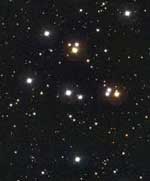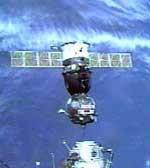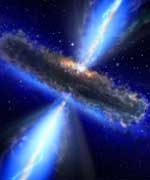
Image credit: NOAO/AURA/NSF
Monday, April 18 – Tonight let’s use two bright celestial objects to our advantage to help you locate an outstanding galactic cluster – M44. Because this great gathering of stars is located near the ecliptic plane, you will find it easily tonight in binoculars by scanning the area mid-point between Saturn and the Moon. Also known as the “Beehive”, this wonderful open cluster is sufficiently bright enough to be seen unaided under darker conditions. In ancient times it was used as a weather predicting tool – if it was not visible under otherwise clear skies – a major storm was on the way. This easy collection of bright pairs was known and recorded as far back as 260 B.C. – but in 1610 Galileo was the first to resolve it into individual stars with his newly invented telescope. Enjoy its stellar “swarm” tonight…
Continue on to the lunar surface to explore the very fine appearance of crater Copernicus located about mid-way along the terminator. It is not the largest, the deepest, the oldest, the most bright, nor the most unusual of lunar features – but it definitely holds the record at being the most spectacular!
Tuesday, April 19 – A little more than 35 years ago, the Apollo 13 crew was on a mission to land on the Moon in the Fra Mauro highlands. Although disaster kept them from completion, Apollo 14 carried out the plan a little less than a year later – and tonight we will be able to see this landing area on the lunar surface. Along the terminator to the south, you will see a dark expanse known as Mare Nubium. On its northern shore and nearing the terminator’s center, you will see a inlet of small shallow craters. The brightest of these small rings is crater Parry with Fra Mauro appearing larger and more shallow to its north. Power up! Fra Mauro has a long fissure that runs between its north and south borders. At the northern crater edge you will see the ruins of an ancient impact. Known as X, it definitely marks the spot of this successful lunar landing.
Wednesday, April 20 – Tonight the most prominent lunar feature will be the ancient and graceful Gassendi. Its bright ring stands on the north shore of Mare Humorum – an area about the size of the state of Arkansas. Around 113 km in diameter and 2012 meters deep, you will see a triple mountain peak in its center and the south wall eroded by lava flows. Gassendi offers a wealth of details to telescopic observers on its ridge and rille covered floor.
When you have finished with your lunar observations, let’s travel on to a fascinating double star. A little less than a handspan south of the last star in the handle of the “Big Dipper”, you will see a fairly bright star that is on the edge of unaided eye detection thanks to tonight’s gibbous Moon. Aim your telescopes or steady binoculars there for a real treat! Alpha Canum is more commonly known as Cor Caroli – or the “heart of Charles” – and is a true jewel easily split by the most modest of instruments. Although some observers may not be able to distinguish a color difference between the magnitude 2.8 and 5.6 companions, it has been my experience that most will see a faded blue primary (a magnetic spectrum variable) and pale orange secondary on this 120 light year distant pair. If you are equatorially aligned, turn off the drive and wait for 150 seconds. Widely separated Struve 1702 will be coming into view…
Thursday, April 21 – Tonight’s lunar observing will be a challenging one – worthy of the larger scope. Start by identifying past study craters, Hansteen and Billy. Due west of Hansteen you will find a small crater near the terminator known as Sirsalis. It will appear as a small, dark ellipse with a bright west wall with its twin, Sirsalis B on the edge. The feature you will be looking for is the Sirsalis Rille – the longest presently known. Stretching northeast of Sirsalis and extending for 459 kilometers south to the bright rays of Byrgius, this major “crack” in the lunar surface will show several branches – like a long dry river bed.
Tonight let’s go from one navigational extreme to another as viewers in the northern hemisphere try their hand at Polaris. As guide star for north, Polaris is also a wonderful double with an easily resolved, faint blue companion for the mid-sized telescope. But what about the south? Viewers in the southern hemisphere can never see Polaris – is there a matching star for the south? The answer is yes – Sigma Octantis – but at magnitude 5, it doesn’t make a very good unaided eye guide. Ancient navigators found better success with the constellation of Crux, better known as the “Southern Cross”. While Crux has many wonderful double stars, if southern hemispere viewers would like to see a star very similar to Polaris, then try your luck with Lambda Centauris. The magnitude difference between components and separation are about the same!
Friday, April 22 – Today celebrates the birthday of Sir Harold Jeffreys, who was born in 1891. Jeffreys was an astrogeophysicist and the first person to envision Earth’s fluid core. He also helped in our understanding of tidal friction, general planetary structure, and the origins of our solar system. Start your morning off before dawn with a chance to view the peak of the Lyrid meteor shower. Since the radiant is near Vega, you will improve your chances of spotting them when the constellation of Lyra is as high as possible and the Moon far to the west. This stream comes from parent Comet Thatcher and produces around 15 bright, long-lasting meteors per hour. (UPDATE: The current projected peak time has been upgraded to 10:30 UT.)
But what about later?
The Moon will be very busy tonight… On this universal date it will occult Jupiter in regions across mid-to-south Africa. Since we have many readers from that area, please watch! This IOTA webpage will give you precise universal times for your location. As the Earth turns, a wide swath across the southeast, central and western portions of both North and South America, will enjoy the Moon occulting Eta Viriginis. Be sure to visit this IOTA webpage for a list of universal times in your area.
Saturday, April 23 – Pioneer quantum physicist, Max Planck was born on this day in 1858. In 1900, Max developed the quantum – known as the Planck equation- to explain the shape of blackbody spectra (a function of temperature and wavelength of emission). A “blackbody” is any object that absorbs all incident radiation – regardless of wavelength. For example, a heated metal has blackbody properties because the energy it radiates is thermal. The blackbody spectrum’s shape remains a constant and the peak and height of an emitter can be measured against it – be it cosmic background radiation or our own bodies.
Now, let’s put this knowledge into action. Stars themselves approximate blackbody radiators, because their temperature directly controls the color we see. A prime example of a “hot” star is Alpha Viginis, better known as Spica. Compare its color to the cooler Arcturus… What colors do you see? There are other astronomical delights that radiate like blackbodies over some or all parts of the spectrum as well. You can observe a prime example in a nebulae, such as the M42 in Orion. By examining the radio portion of the spectrum, we find the temperature properly matches that of electrons involved in the process of flourescence. Much like a common household fixture, this process is what produces the visible light we can observe.
Sunday, April 24 – For central and western North America, this would be an excellent morning to set the alarm for the early hours as the Moon undergoes a penumbral eclipse – reaching its deepest at 09:55 UT. The effects of the shading of a penumbral eclipse are not as dramatic as the umbral portion, but it’s still fun! For viewers in Central America and western South America, the event will happen before dawn. Hawaii will catch the action around local midnight, while Australia, New Zealand and Japan will have their opportunity in the early evening.
Just because we have full Moon doesn’t mean we can’t have any fun. Tonight let’s explore the star in the middle of the handle of the “Big Dipper”. Its name is Mizar, but if you have exceptional eyes you may also see its companion Alcor as well! The ancient Arabs used this star as an “eye test” for their warriors – if you could see both components, you were given a horse. The name Mizar and Alcore literally translates to “the horse and rider”. If it’s not clear to you, even the slightest optical aid will separate the two, but a treat is in store for telescope users. Mizar itself is a double star! As the very first to be discovered and photographed, you will enjoy this pair. In the eyepiece, Alcor will appear to the east of Mizar A and B, but look for a faint star in between. It has the very impressive name of Sidus Ludovicianum and was once believed to be a planet.
Until next week? Ask for the Moon – but keep reaching for the stars! Light speed…. ~Tammy Plotner


